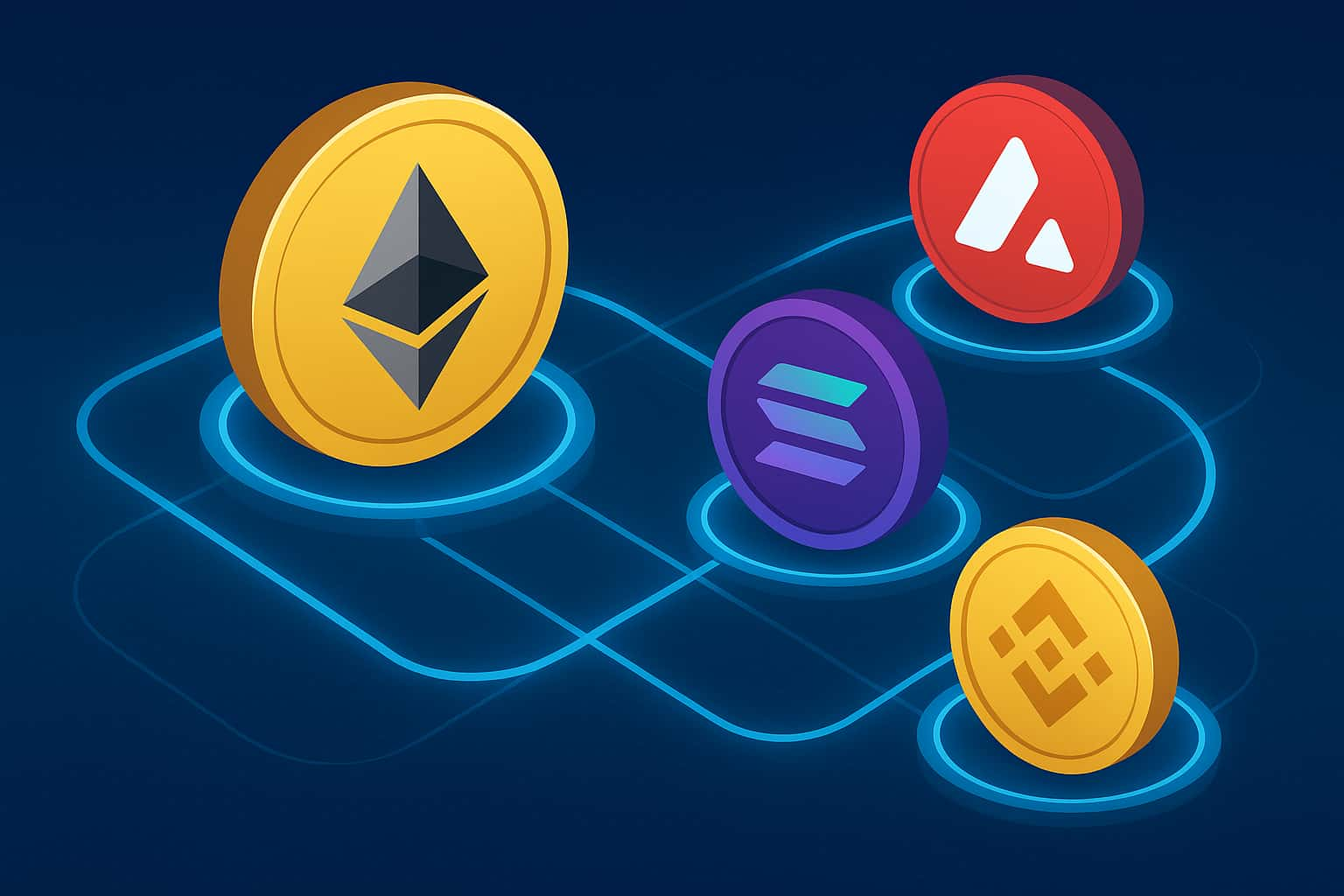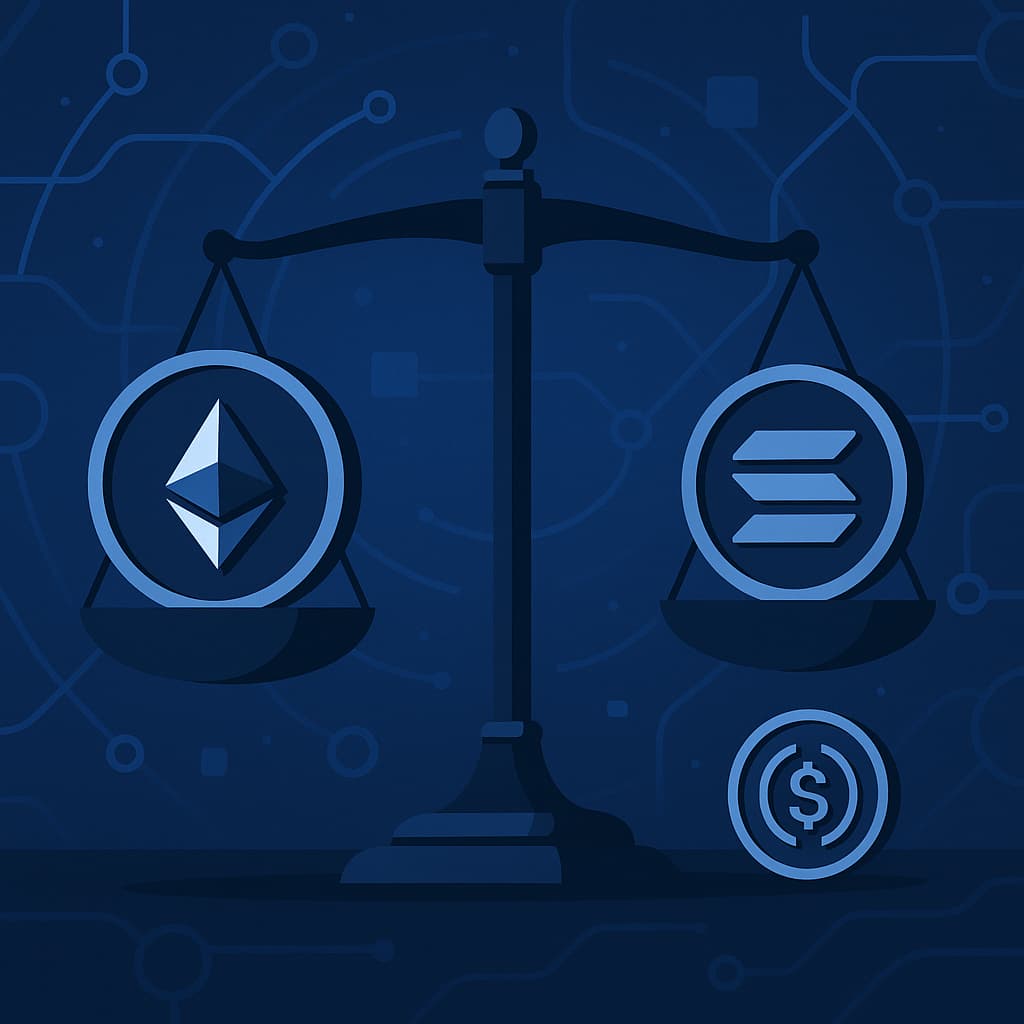-
Stablecoins are now the backbone of on-chain commerce, powering cross-border remittances, DeFi collateral, and increasingly, traditional finance settlement rails. Daily transfer volumes on-chain exceed US$150 billion, underscoring their critical role in the digital economy. The asset class has begun to attract attention from central banks and big-tech players, reflecting its growing legitimacy. PayPal's launch of PYUSD in August 2023 marked the first major Web2 entrant, and its upcoming on-chain rewards program in Q3 2025 shows how mainstream wallets are reshaping payments. For businesses entering this market, working with a stablecoin development company is essential.
What Exactly is a Stablecoin?
A stablecoin is a cryptographic token engineered to maintain a predictable value, most commonly 1 USD, 1 EUR, 1 gram of gold, or an inflation-adjusted index. Unlike volatile assets such as BTC or ETH, a stablecoin's unit-of-account property makes it suitable for:
- Medium of exchange – low-slippage trading pairs across CEXs/DEXs.
- Store of value – hedging against emerging-market inflation.
- Unit of account – denominating smart-contract obligations (loans, invoices, salaries).
Historically, dollar-pegged coins dominate because the USD is the global reserve. But euro-denominated and CPI-linked coins are growing rapidly; FRAX's FPI even tracks US inflation directly.
Also, Explore | AI-Powered Stablecoin Development | Streamlining Stability
A Deep Taxonomy of Stablecoins
Category Peg Mechanism Collateral Source Examples Stability Levers Risk Profile Fiat-backed (custodial) 1:1 reserve held by a regulated custodian Bank deposits, T-Bills USDC, USDT, PYUSD Monthly attestations, redemptions Counter-party risk, regulatory Crypto-collateralised Over-collateralised vaults ETH, wBTC, LSTs DAI (Maker), LUSD Liquidations, stability fees, surplus auctions On-chain volatility, oracle Algorithmic (elastic-supply) Supply expands/contracts via bonding curves or seigniorage None or partial AMPL, early UST Rebase, buy-back + burn High de-peg risk Hybrid / Fractional-Algo Partial collateral + algorithmic buffer USDC + governance token FRAX v3 AMOs, TWAMM, lending markets Medium risk, more flexible Commodity-backed Metal or energy reserves Bullion vaults PAXG, DGX Custodian audits Storage, custody Strategic Reasons to Issue a Stablecoin
- Payment Rails & Treasury Operations – Eliminate multi-day SWIFT settlement and enable 24/7 programmable treasury flows.
- DeFi Liquidity Mining – Seed liquidity pools with your own unit of account and capture protocol fees.
- Platform Loyalty & UGC Economies – Gaming studios and creator platforms lock in users with branded USD-pegged tokens redeemable for services.
- Regulatory Buffer – Segregate client funds, provide on-chain proofs of reserve, and satisfy MiCA's real-time reporting mandates.
- Monetary Experimentation – Algorithmic models can explore CPI-tracking, regional currency baskets, or carbon-indexed units without launching a new L1.
Core Architecture: The Six Moving Parts
- Token Contract – Usually ERC-20/BEP-20/SPL; exposes
mint,burn,transfer. - Collateral Vault / Reserve Ledger – Tracks locked assets (on-chain or off-chain).
- Price Oracle – Medianised USD feed (Chainlink, Pyth, RedStone).
- Stability Engine – Liquidation bots, rebase logic, or AMO market operations.
- Governance Layer – Multisig → DAO (time-lock) → fully permissionless upgrade path.
- Compliance Layer – KYC/KYB registry, blacklist, and on-chain Travel Rule metadata.
These components map 1-to-1 onto the microservices you'll deploy if you're using a modular back-end such as NestJS, Go-Micro, or Rust Axum. Each module must be audited in isolation and as part of the systemic whole.
Also, Check | Best Blockchain Platforms for Stablecoin Development
Selecting Your Settlement Layer (Blockchain)
Chain TPS* (real) Finality Dev Language DeFi TVL Notes Ethereum L1 12-15 ~12 sec Solidity/Vyper $60 B Liquidity depth & institutional comfort; high fees. Optimistic L2s (OP, Base) 2k+ <15 sec Solidity $16 B Cheap, inherits L1 security; 7 day withdraw delay. ZK-Rollups (Scroll, zkSync) 1-5k <5 sec Solidity/Vyper $4 B Fast exit proofs, higher EVM equivalence cost. Solana 50k+ ~400 ms Rust/Anchor $3 B Blocktimes + priority fees; centralisation debates. BNB Chain 300 3 sec Solidity $6 B Large retail base; validator set controlled by BNB. Cosmos SDK 10k+ 2-6 sec Go modules $1 B Sovereign app-chain, customise gas & staking params. Throughput numbers are conservative real-world estimates, not theoretical maxima.
Smart-Contract Design Patterns in Detail
Below is a hardened ERC-20 skeleton, extended for permit signatures (EIP-2612) and upgradeability via UUPS proxies. Use OpenZeppelin Wizard to scaffold quickly.
// SPDX-License-Identifier: MIT pragma solidity ^0.8.24; import "@openzeppelin/contracts-upgradeable/token/ERC20/extensions/draft-ERC20PermitUpgradeable.sol"; import "@openzeppelin/contracts-upgradeable/access/AccessControlUpgradeable.sol"; import "@openzeppelin/contracts-upgradeable/proxy/utils/UUPSUpgradeable.sol"; contract StableUSD is ERC20PermitUpgradeable, AccessControlUpgradeable, UUPSUpgradeable { bytes32 public constant MINTER_ROLE = keccak256("MINTER_ROLE"); /// @custom:oz-upgrades-unsafe-allow constructor constructor() initializer {} function initialize() public initializer { __ERC20_init("Stable USD", "sUSD"); __ERC20Permit_init("Stable USD"); __AccessControl_init(); _grantRole(DEFAULT_ADMIN_ROLE, msg.sender); _grantRole(MINTER_ROLE, msg.sender); } function mint(address to, uint256 amount) external onlyRole(MINTER_ROLE) { _mint(to, amount); } function burn(uint256 amount) external { _burn(msg.sender, amount); } /// UUPS authorisation function _authorizeUpgrade(address) internal override onlyRole(DEFAULT_ADMIN_ROLE) {} }Key Pattern Highlights
- Role-Based Access – separate
MINTER,PAUSER,UPGRADER. - Permit – gasless approvals for DeFi composability.
- UUPS – cheaper upgrades than Transparent Proxy; ensure a 48-hour timelock and on-chain vote before executing
_authorizeUpgrade. - Hooks – override
_beforeTokenTransferto apply blacklists or transfer limits.
You may also discover | PayPal Launches its U.S. Dollar Stablecoin PayPal USD (PYUSD)
Collateralisation Mechanics & Risk Modelling
Fiat-Backed
- Reserve Composition – 20 % demand deposits, 80 % T-Bills ≤90 days.
- Duration Matching – Liability = instant redemption; Asset duration must be ≤ redemption window.
- Attestations vs. Audits – Monthly attestations are table stakes; MiCA will require daily reserve reporting starting Dec 30, 2024. citeturn0search0
Crypto-Backed (Vault Model)
- Loan-to-Value (LTV) – MakerDAO uses 150 % for ETH-A.
- Liquidation Call – When
VaultValue / Debt < CollateralRatio, keepers trigger the auction. - Penalty Rate – A 13 % penalty gets added to the debt in Maker's English auctions.
Risk Tools
- Value-at-Risk (VaR) simulation across oracle shock scenarios.
- Circuit Breakers – Global debt ceiling, daily mint caps, per-account caps.
Algorithmic / Hybrid
- AMO (Algorithmic Market Operations) – FRAX v3 directs excess collateral into Fraxlend & Fraxswap to defend the peg passively. citeturn0search5turn0search11
- Reflexivity Dampeners – Dynamic redemption fees that rise when price deviates >0.3 %.
- Negative Yield Environments – For CPI-pegged coins, supply contraction (burn) distributes negative yield via rebasing.
Also, Check | Stablecoin Applications Development | Emerging Alternative
Price-Oracle Design & Integration
Multi-Layer Oracle Stack
- Primary (on-chain aggregator) – Chainlink ETH/USD medianised over 27 feeds.
- Secondary (fallback) – RedStone pull-based oracle or Pyth for low-latency (esp. Solana).
- Heartbeat & Threshold – Reject any update if
abs(new - last) > 5 %OR if timestamp> 3 min. - Decentralised quorum – N-of-M multisig approves new feed addresses; mandate 2 week delay under governance.
Implementation Tip: Wrap an element
OracleRouter.solthat exposes canonicallatestRoundData()and switches gracefully if the primary feed reverts.Mint/Burn & Redemption Flows Step-by-Step
Fiat-Backed KYC Flow (Off-Chain Trigger)
User → KYC Portal → Submit KYC docs ↓ success Custodian Bank ← USD wire/ACH ← User ↓ confirmation (Fedwire API) Issuer Backend → call `mint()` → Token Contract → _mint(user, amount)Redemption is the mirror process; backend first
burnFrom()then wires fiat.Crypto-Collateralised On-Chain Flow
sequenceDiagram participant U as User participant V as VaultManager participant O as Oracle U->>V: lock 1 ETH V->>O: get ETH/USD price O-->>V: 1 ETH = $2 500 V->>U: mint 1 000 dUSD (LTV 40 %)On burn, the vault unlocks collateral minus any stability fee accrued.
Algorithmic Rebase Cycle
Every epoch (e.g., 24 h):
- If Price > $1.01 → expand supply:
delta = (price -1) * supply. - If Price < $0.99 → contract supply via buy-back or negative rebase.
- Governance can throttle
deltato 5 % of supply to avoid reflexive spirals.
Security, Incident Response & Monitoring
- Threat Modelling – Re-entrancy, oracle manipulation, upgrade-key compromise.
- Real-Time Alerting – Use Tenderly Actions to listen to
Transferevents > $5 M, or symmetricmint/burnanomalies. - Bug-Bounty Program – Minimum $1 M dedicated pool (Immunefi / HackenProof).
- Key Management – Use HSMs or MPC (Fireblocks, Coinbase Cloud) for mint keys.
- Emergency Pause –
Pausablemodifiers gatingmintandburn; 24-hour governance-only unpause. - Table-Top Drills – Simulate Oracle outage and chain re-org scenarios quarterly.
Also, Check | Crowdfunding Your Business Idea with Security Token Offering
Global Regulatory Landscape
Region 2025 Status Key Requirements Source European Union MiCA Title III & IV enter into force 30 Dec 2024; grandfathering until 1 Jul 2026 White-paper filing, daily reserve disclosure, EU legal entity citeturn0search0 United States STABLE Act 2025 draft in House; bipartisan negotiations ongoing Federal charter or state money-transmitter plus FDIC-style disclosure prohibitions citeturn0search1turn0news53 Hong Kong HKMA to finalise licensing regime by Q4 2025 after 108 consultation responses Reserves held at HKMA-designated banks, quarterly audit, management fit-and-proper citeturn0search2 Singapore PSA amendments classify “single-currency stablecoins” (SCS) with reserve and redemption rules Within 5 business days redemption, 100 % SVF backing MAS circular PSN02-2024 Latin America Brazil's PL 4.401/2021 enacted; stablecoin issuers treated as “electronic money institutions” Central-Bank licence, real-time settlement reporting BCB Resolution 261/2024 Practical Tips
- Build modular KYC so you can flip jurisdictions via feature flags.
- Keep a pause-jurisdiction mapping—MiCA demands you block non-EU residents if you exceed issuance caps without authorisation.
- Embed Travel Rule fields (
MessageType6975) into ERC-20transfercalldata using consent layers (ERC-6160 draft).
Testing, Audit & Formal Verification
Layer Tooling What to Look For Unit Hardhat + Waffle / Foundry Logic errors, bounds checks Integration Anvil fork-tests, Tenderly fork-sim Oracle staleness, multi-contract flows Fuzzing Echidna, Foundry forge fuzzOverflow, invariant violations Formal Certora Prover, Kamino Move Prover Liveness, safety properties End-to-End Cypress/Playwright for KYC portal UI/UX + API coherence Audit External (Trail of Bits, Quantstamp, Spearbit) 2 rounds + retest Bug Bounty Immunefi, Code4rena Continuous crowdsourced coverage Always publish static-analysis reports, audit PDFs and proof-of-reserves dashboards to satisfy regulators and sophisticated users.
Deployment, Upgrades & Governance Models
Bootstrapping Phase
- Multisig (3/5) controls
MINTER_ROLE; timelock = 0 h. - Circuit-Breakers = $2 M daily mint cap.
Maturity Phase
- Upgrade to Timelock + GovernorBravo.
- On-chain proposal → 2-day voting → 1-day timelock → execution.
- Caps scale automatically using EWMA of 30-day volume.
Decentralised Phase
- Delegate governance token voting; remove multisig keys.
- Emergency “guardian” role can only pause, never mint.
- DAO treasury funds audits, oracle fees, and AMO strategies.
Also, Check | Security Token Exchange Development – A Comprehensive Guide
Developer Tool-chain & Open-Source Starter Kits
- Hardhat + Foundry – dual test suites, gas reporter.
- OpenZeppelin Defender – automated admin, Relayer for meta-transactions.
- Tenderly Webhooks – production ops & error tracking.
- Anchor (Solana) – IDL-generated TypeScript, PDAs for vaults.
- CosmWasm cw-plus – Rust contracts for Cosmos app-chains.
- StableSuite Boilerplate – community template (Solidity + Next.js + NestJS).
- Proof-of-Reserve Subgraph – The Graph indexer for real-time dashboard.
Best-Practice Checklist
- Separate hot & cold mint keys; MPC for hot.
- Publish monthly attestation and Merkle tree of on-chain reserves.
- Use chain-agnostic token identifiers (CAIP-19) for multi-chain bridges.
- Implement
EIP-4626vault wrappers for composability. - Deploy canary contract to testnet before every upgrade.
- Enforce 2-of-3 oracle consensus before critical calls.
- Run chaos-testing on forked mainnet during volatile markets.
Case Studies
USDC (Centre Consortium)
- Model: 100 % fiat-backed, monthly attestations by Deloitte.
- Scale: $108 B in circulation (Apr 2025).
- Lesson: Transparency + bank-grade custody wins institutional clients.
DAI (MakerDAO)
- Model: Over-collateralised; ETH, stETH, real-world assets (US T-Bills via BlockTower).
- Innovation: Multi-collateral vault types, surplus auction burning MKR.
- Lesson: Decentralised governance can adapt collateral mix quickly during black-swan events.
FRAX v3
- Model: Fractional-algorithmic with on-chain AMOs (Fraxlend, Fraxswap).
- Update 2024-Q4: “All-weather” reserve model to maintain >100 % total CR dynamically. citeturn0search5turn0search11
- Lesson: Diversified on-chain yield sources can stabilise peg without full fiat backing.
PayPal USD (PYUSD)
- Model: Custodial, Paxos-issued; integrates directly into PayPal & Venmo.
- Milestone 2025: Rewards program to incentivise holding & spending. citeturn0search4
- Lesson: User-facing brands leverage distribution, not DeFi yield, to drive adoption.
Emerging Trends to Watch
- MiCA Title IV Implementation – Expect quasi-bank reporting standards, daily reserve APIs, and EU-only promotion permissions. citeturn0search0
- US Federal vs. State Regulatory Clash – STABLE Act could pre-empt state charters; lobbying intensifies through 2025. citeturn0search1
- CBDC-Stablecoin Interoperability – APIs for programmable euro cash tokens (e.g., Banque de France DL-Trezor pilot) interacting with ERC-20 stablecoins.
- ZK-Proof-of-Reserves – Kraken, Circle pilot snark-based audits (no auditor trust).
- RWAs & Yield-Bearing Stablecoins – Tokenised T-Bills feeding directly into on-chain AMMs; Maker's “Endgame” and BlackRock's BUIDL bridging.
- Account-Abstraction Wallets – ERC-4337 paymasters supporting gas-in-stablecoin for web2-style UX.
-
AI-Optimised Monetary Policies – Reinforcement-learning agents adjust fee parameters for algorithmic models in real-time.
Also, Discover | The Emergence of Stable Coins: An Alternative to Cryptocurrencies
Frequently Asked Questions
Q1 — Do I need a banking licence to issue a stablecoin?
In the EU: yes, under MiCA, you will need EMI-like authorisation for significant tokens (≥$5 B in circulation). In the US: current drafts require Fed supervision unless you stay under state MT regimes. citeturn0search0turn0search1Q2 — How do I keep my coin from de-pegging on thin liquidity?
Deep DEX liquidity, AMM incentives, multi-venue arbitrage bots, and emergency market-buy reserves are mandatory.Q3 — Can an algorithmic model ever be “safe”?
Risk is inherent but mitigated with partial collateral (hybrid design), TWAP oracles, and dynamic redemption fees.Q4 — What's the minimum viable attestation cadence?
Regulators trend toward daily (MiCA) or weekly (HKMA draft). Anything slower than monthly is already outdated in investor eyes.Conclusion & Next Steps
Stablecoin engineering in 2025 is no longer a weekend Solidity project; it is financial infrastructure. Whether you're venture-backed, a fintech incumbent, or a DAO spinning up ecosystem liquidity, the golden triangle is stability, transparency, and compliance.
In case if you are looking for stablecoin development services, connect with our blockchain developers to get started.

Our Offices
INDIA
Emaar Digital Greens, Sector 61,
Gurugram, Haryana
122011.
Welldone Tech Park,
Sector 48, Sohna road,
Gurugram, Haryana
122018.














